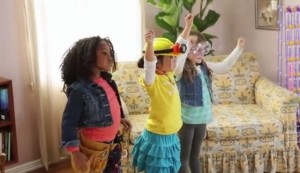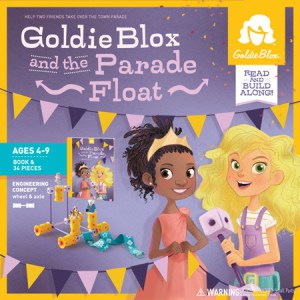If you care about smart toys or if you don’t live under a media rock, then by now you’ve heard about GoldieBlox, the girls engineering toy. Maybe you read about it here at Girl w/Pen. Maybe you saw the viral video about the toy that parodied the Beastie Boys song, “Girls.” In the video, three girls set off a Rube Goldberg machine and aim to take over the world. The only problem was that the Beastie Boys said thank you by suing GoldieBlox. Then the toy got critiqued left and right—too pink, too princessy, too wrong for “stealing” a Beastie Boys song. Well now, no matter how you felt about the toy, you likely saw their new ad while inhaling nachos during the Super Bowl. GoldieBlox won Intuit’s small business Super Bowl commercial competition which means they essentially won 4 million dollars, the amount equivalent to make and then screen a commercial during the Super Bowl.
And that means that GoldieBlox really just became a household name.
This commercial puts GoldieBlox, a small start-up toy company that wants to, as they say, “disrupt the pink aisle,” at your local toy store, back on top. And to make matters even better, days ago GoldieBlox’s “Spinning Machine” won the People’s Choice and Educational Toy award of the year at the 14th annual Toy Industry Association (TIA) Awards. Debbie Sterling, GoldieBlox CEO, invented one of the first engineering toys for girls. She shares her challenges in her TEDX talk: her path as a female minority in a Stanford engineering program, a woman inventor in the big business androcentric toy industry, and as a female entrepreneur in booming Silicon Valley. Sterling’s vision as an entrepreneur, and the ideological work of the toy, are the reasons we wanted her to help us open a new gender center, the Cassandra Voss Center, on our campus. So this Fall, we became the “Midwest launch” of GoldieBlox.
What did that mean? Debbie Sterling and VP, Lindsey Shepard, spoke on our campus and taught us how to engage hundreds of kids with GoldieBlox when we created a toy zone in our Center. St. Norbert College was also among the first colleges to include the toy in their curriculum. As Assistant Professor of Education, Chris Meidl, said when he introduced the toy in his class on “Play,” “No matter any other criticisms about the toy itself, the clear message delivered is that girls can build too. And that is a message worth being heard, for girls and boys, for women and most importantly for men.”
So I’m loyal-it’s true. I know the founders personally and heard them speak passionately about their dream of the toy and for girls globally. The toy, though, has come under a lot of critique. When Slate’s holiday gift guide tagline read “Forget GoldieBlox. Buy a Birdfeeder Instead,” I wanted to throw a birdfeeder at my computer screen. The holiday season is, of course, the biggest commercial moment in the toy company year. Slate just kept going with, “First Everyone Loved GoldieBlox. Now Everyone Hates GoldieBlox.” Hate is a strong word and I guess Slate figured that out since at this writing, they removed the above title and have given GoldieBlox a second look under the article, “GoldieBlox: Great for Girls? Terrible for Girls? Or Just Selling Toys?” Well good for you Slate for modifying your backlash after the fact. Sigh. Then when Jezebel recently wrote, “GoldieBlox Means Well But Doesn’t Live Up to the Hype,” I had to weigh in.
I’ve been in Women’s and Gender Studies since I was 19 years old. On the one hand, I welcome and get the onslaught of feminist critique of GoldieBlox that is now coming to a blog near you. On the other hand, I am no ideological purist and I wonder the degree to which critics grasp what it takes to break gender barriers in all these fields—STEM, toy industry, start-up/Silicon Valley culture—and make a toy that has mass appeal. I repeat—mass appeal.
My supportive response really comes from watching the toy work on the ground. I saw hundreds of girls play with GoldieBlox for an entire day. I watched as girl after girl mastered a “basic belt drive,” the first engineering challenge of the game and saw how they interacted with the “bill of materials” that is designed to be especially welcoming to girls—girls who rarely play with construction toys. Debbie made the wheels look like thread spools, the axles resemble crayons, and the belt mimic a thick hair ribbon. A hair ribbon is stereotypically feminine, but it’s likely a girl has seen one, unlike other construction toy parts that can appear off limits in gender-segregated toy aisles. Debbie conducted research for her start-up toy and discovered that girls would frequently turn her prototypes into non-competitive games. In other words, girls needed all the adorable animal characters to spin on the spinning machine or ride the float. Everyone needed to win. So Debbie redesigned the game.
Now as a gender critic, I know that girls are socialized into these sensibilities rather than born into them, but that fact does not make their gender socialization any less real. When my three year old picked up the toy, she gravitated first to the character animals just as GoldieBlox VP Lindsey Shepard had predicted. “The character animals are the way for girls to feel invited into engineering,” said Lindsey who urged us to reach out a hand with, say, Katinka the dolphin, and welcome a girl into play. The GoldieBlox mission is to make engineering as appealing a job for a girl as the pink-collar work that so many girls are still ushered into. Debbie’s basic gender critique in her Kickstarter video asserts a claim in Gender Studies about inequity and representation—engineering is still 89% male, women make up half the population, women and girls need to be building for a better, more inclusive future. Few toys offer such a gender critique which is why GoldieBlox had an initial feminist appeal.
Critics say about the toy: it has pink on it. And the second game is called “GoldieBlox and the Parade Float” where girls partake in dreaded “princess culture” and help build a parade float. It’s all true. The toy has pink on it, but is mostly yellow. Debbie talked about how using some pink was intentional. She aimed for girls to “want to pick the toy up,” in the first place. Debbie said recently to the New York Times, “It’s OK to be a princess. We just think girls can build their own castles too.” The deeper story of the princess float—and I loathe princess culture…I avoid saying the word out loud in my house—is that Goldie’s best friend, Ruby, who is African-American, is actually the winner of the pageant. This fact prizes afro-centric beauty in a racist culture that makes beauty synonymous with whiteness. Now it is certainly more troubling that Ruby is the best friend of Goldie and not Goldie herself. Goldie of the Blox is a white protagonist, a central critique that is rarely mentioned in the feminist response. Though I wonder if Goldie is “Golda,” an homage to Debbie’s Jewish foremothers. The Jewish cultural allowance for smart girls is something Debbie mentions in her TEDX talk. On the ground, watching girls play with the toy, they actually play with the animals in the set which are not necessarily racialized. The question remains: can a toy ever be designed (add books, movies, etc.) with a girl of color at the center? Girls and women are barely represented authentically in mass culture at all, let alone women of color. We know something will have shifted with a girl-of-color is at the center of a story.
So the answers to the GoldieBlox critiques are a bit more complicated. I appreciate critic Deborah Siegel’s more balanced provocatively titled piece, “Is GoldieBlox Trojan Princess, or Trojan Feminism?” I think it’s both. Which brings me back to my point about ideological purity. Why do we keep asking this binary question of “is it or isn’t it” feminist? Let’s step back and take the long view. The truth is I want GoldieBlox to have the same appeal as Bob the Builder or Lego dudes because girls still get nada in girl toy world. Like I teach my students—you can hold conflicting ideas simultaneously and still make a commitment. GoldieBlox is listening. Let’s commit to help them navigate the hyper-stereotyped toy world many of us are resisting by giving them some advice as The Brave Girls Alliance is doing with Lego when asking them to make smart girl Minifigs. I appreciate that GoldieBlox is trying to meet girls where they are. We can find the common ground between these worlds intellectually and maybe we can even find it around play. And even if we can’t, GoldieBlox is about to change play nationally regardless.



Comments 2
MK — February 22, 2014
To be fair to the Beastie Boys, Goldieblox used their property in a commercial context without their permission, and preemptively sued the band for injunctive relief. The Beastie Boys filed a counterclaim in response, as the band has a policy of not allowing the use of their songs in advertising.
Elline — February 24, 2014
So glad to be in dialogue with you, Karlyn, on Girl w/Pen! It's wonderful to hear firsthand about your experiences seeing girls work with GoldieBlox and their reactions. In my own response piece, since I hadn't seen girls actually use the toy, I considered the outpouring of responses I read, largely from parents. As you write, breaking the toy down into binaries isn't necessarily useful and measuring its degree of "feminist intention" is virtually impossible.
Parents who wanted to see innovation in the "pink aisle" often embraced Sterling's contribution; those who wanted to throw out the divided aisles altogether often found her approach pandering or even patronizing. Many, of course, were conflicted, wondering, as perhaps her very product represents, how best to enact useful change and by what degree(s).
Another conundrum seems to be simply how marketing affects a product -- or is perceived to be needed. I wonder how firmly Sterling felt strongarmed into some "pinkification" or the princess theme just to attract market attention? Much critique of the company seems to have come during their media freefall after GoldieBlox made a rapid move to sue the Beastie Boys (not the other way around).
I'd love to hear more about the Center you work with and its innovations around gender and identity, particularly with girls. Inclusion of their own ideas about how marketing can change, or their needs can be represented and met, and having this amplified, would seem like progress, particularly if this can reach Sterling herself.
http://thesocietypages.org/girlwpen/2013/11/27/off-the-shelf-goldieblox-builds-on-weak-foundation/#comments